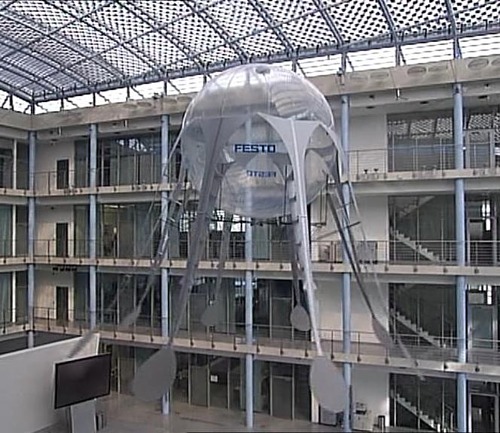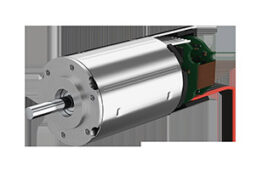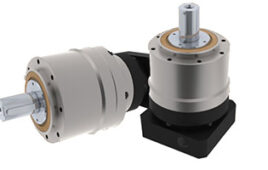From October 23-25, 2008, more than 600 remarkable thought leaders, influencers and social change agents will convene in Camden, Maine for Pop!Tech, the acclaimed annual ideas summit. Now in its 12th year, the event explores the new ideas, technologies and forces of change shaping our future. This year, the conference will also present three Bionic exhibits by Festo: AquaJelly and AirJelly, whose structure and kinematics are based on their biological model, the jellyfish; and Air_ray, which is modelled on the manta ray and floats through a sea of air.
Bionic Learning Network
Bionics is a young scientific discipline combining biology and technology generating an abundance of concepts for high technology and serving as inspiration for technical developments. Bionics allows a visionary view towards potential future applications. In this promising field, Festo has been involved with its Bionic Learning Network for several years. The Bionic Learning Network is part of the Festo commitment to technical education and training. In cooperation with students, major-name universities, institutes and development companies, Festo supports projects and prototypes which extend beyond its core segments of Automation and Didactic and which may produce interesting application fields of the future. The aim is to make automated movements even more efficient and productive with the aid of bionics. The Bionic Learning Network demonstrates fascinating solutions to complex problems.
Air_ray
Air_ray, modelled on the manta ray, is a remote-controlled hybrid construction comprising a helium-filled ballonet and a flapping-wing drive mechanism. The extremely light design enables it to almost hover in the air by means of the buoyant force of the helium ballonet – , floating through a sea of air just as the manta ray does in water.

The propulsion is affected by a flapping-wing mechanism. The wing module, which can be moved up and down by a servo drive unit, has a structure that makes use of the Fin Ray Effect‚® ‚– a construction design derived from the functional anatomy of a fish fin. This structure consists of two alternating pressure and tension flanks flexibly connected by ribs. When one flank is subjected to pressure, the geometrical structure automatically bends in the direction opposed to the force applied. A servo drive unit pulls on the two flanks longitudinally in alternation, moving the wing module up and down. The structure is supplemented by a torsion-resistant central spar. Mounted to its exterior end is a servo drive unit that enables the flapping wing to rotate about its transverse axis, so that Air_ray can fly backwards. The pitch elevator is also designed as a Fin Ray structure driven by a servo unit.
AquaJelly
AquaJelly is an artificial autonomous jellyfish with an electric drive and an intelligent, adaptive mechanical system. AquaJelly consists of a translucent hemisphere and eight tentacles used for propulsion. At the center of the AquaJelly is a watertight, laser-sintered pressure vessel. This comprises a central electric drive, two lithium-ion-polymer batteries, the charge control device, and the servo motors for the swashplate.

The structure of each tentacle uses the Fin Ray Effect‚® described above. It moves with the aid of a peristaltic propulsion system, or wave-like contractions, based on the reaction thrust principle used by its biological precursor. The motion of the AquaJelly in three-dimensional environments is controlled by shifting its weight. Two servo motors integrated into the central pressure vessel actuate a swashplate. This swashplate controls a four-arm pendulum which can be steered in the four spatial directions. When the pendulum moves in a certain direction, the jellyfish‚’s center of gravity changes towards this direction.
AquaJelly is capable of independently controlling its own energy supply by means of communication between the AquaJelly and a charging station. Whenever the AquaJelly comes to a charger located above the water basin, it is sucked towards it and provided with electricity.
For communication on the water surface, the AquaJelly can use the energy-conserving short-range radio standard ZigBee, which enables it to exchange status details with the charger and signal to other AquaJellies on the surface that the charger is occupied. The main communication medium underwater, however, is light. The AquaJelly has eleven infrared light-emitting diodes with which it can communicate over distances of up to approx. 80 cm. The pulsed infrared signals are sent from inside an almost spherical structure around the AquaJelly. On receiving a position signal from an approaching jellyfish, the AquaJelly can start its evasion maneuver in plenty of time. In addition to environment sensors, the AquaJelly also has internal sensors which monitor its energy level as well as a pressure sensor which allows it to gauge its depth in the basin to within a few millimeters.
Each jellyfish decides autonomously which action to carry out on the basis of its current condition. This central electric drive, combined with an adaptive mechanical system and intelligent autonomous electronics, opens up possible new applications for self-controlling systems. If a large number of AquaJellies were equipped with communicative abilities, these could act like a shoal with the behavior pattern of a more highly developed system. If one applies this principle to automation, then numerous autonomous or semi-autonomous intelligent systems might be able to work together. In this way, large problems could be solved by small systems working together in harmony.
AirJelly
Air is the element of the AirJelly. Rather than swimming through water like the AquaJelly, it glides through the air with the aid of its central electric drive and an intelligent, adaptive mechanical system. The remote-controlled AirJelly is kept in the air by its helium-filled ballonet.

The AirJelly‚’s only energy source are two lithium-ion-polymer batteries, to which the central electric drive is attached. This transmits its power to a bevel gear and then to eight spur gears, which drive the eight tentacles of the jellyfish via their respective cranks. The structure of each tentacle is based on the Fin Ray Effect‚®. Using a peristaltic movement to drive a balloon was previously unknown in the history of aviation. The AirJelly is the first indoor flying object to use such a peristaltic propulsion system. The jellyfish glides gently through the air thanks to this new drive concept based on the reaction thrust principle.
The AirJelly steers through three-dimensional environments by shifting its weight. Its two servo motors are located at the ‚“North pole‚†of the jellyfish and controlled proportionally. If the pendulum moves in one direction, the AirJelly‚’s center of gravity shifts in this direction allowing the AirJelly to ‚“swim‚†in any spatial direction. The propulsive force of the drive can be varied by moving the Fin Ray‚® tentacles more quickly or slowly.
Pop!Tech
Pop!Tech is a renowned ideas summit and social innovation network dedicated to accelerating the positive impact of world-changing people and ideas. The organization is known for its visionary Pop!Tech conferences, engaging media productions, and the innovative social change programs that it fosters worldwide.
‚“Pop!Tech 2008: Scarcity and Abundance‚†will be simulcast live on www.poptech.org/live and explore the rapidly-changing 21st century dynamics of scarcity and abundance. The event will chart the core scarcities humans and organizations will encounter this century and how a wealth of new innovations, bottom-up approaches to collaboration and insights into collective wisdom might hold the keys to addressing the challenges that lie ahead. Many different domains will be explored, from the social web to population growth and energy consumption, from truly sustainable business models to politics and peacemaking. An eclectic group of visionaries will help drive the discussion, including familiar names like Malcolm Gladwell, Chris Anderson and Clay Shirky, plus soon-to-be familiar names such as Stephen Badylak, Kelly Dobson, Bill Bishop, Saul Griffith, Pamela Ronald and Gary Slutkin.
::Design World::
Filed Under: Motion control • motor controls





Tell Us What You Think!